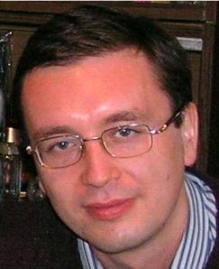
Associate Professor
Born 1 July 1974 in Moscow, Russia.
Graduated from the Physics Faculty of Moscow State University with an excellence degree in 1997.
PhD in physics in 2000. PhD thesis title: Gauge dependence of effective action in quantum gravity.
Combustion researcher at Post Doc. position at the Physics Faculty of Uppsala University, Sweden, 2001.
Invited Researcher at the Laboratory of Combustion and Detonation, Poitiers University, France (2007-present).
Associate Professor at the Physics Faculty of Moscow State University (2005-present).
Lectures (2001-present)
Theoretical mechanics.
Quantum mechanics.
Renormalization of gauge theories.
Research fields of interest
Combustion: nonlinear development of the Darrieus-Landau instability of premixed flames, nonlinear flame stabilization and steady flame propagation, asymptotic methods, small gas expansion limit, non-perturbative description of curved flames, flame propagation in gravitational field, propagation of diffusion flames in counterflows.
Quantum Field theory & Gravitation: Quantum fluctuations, Flicker noise, low-energy quantum gravity, correspondence between classical and quantum theories, the gauge dependence problem, post-Newtonian classical and quantum corrections, gravitational potentials, black holes, renormalization of gravity models, modeling of the measurement process.
Current research and future plans
Combustion:
Since all laboratory flames are characterized by large thermal expansion of gases, their dynamics in the regime of saturated nonlinearity can be investigated only non-perturbatively. The first consistent non-perturbative approach to the steady flame propagation was developed in [13,14]. Specifically, an integral representation for the rotational component of the burnt gas velocity near the flame front, along with a nonlinear dispersion relation for the potential component were derived and combined in an exact equation relating fuel velocity at the flame front and the flame front position. Together with the evolution equation (which determines the local burning rate), the new equation thus describes flame propagation entirely in terms of quantities defined on the flame front. This approach, now known as the on-shell description of flames, has been extended to the unsteady case in [10,11] and successfully applied to various problems such as stability of confined V-flames [5], anchored flames in high-velocity streams [4], flame propagation in curved channels [6], and horizontal flame propagation [1]. All these problems are inaccessible for the classical analysis based on explicit solving of the bulk flow equations. The new method also provides a convenient framework for carrying out an asymptotic analysis of the weak gas-expansion case. It is planned to apply this method to open Bunsen and V-flames, vertical flame propagation, flame acceleration in open tubes.
Electromagnetic fluctuations and Flicker (1/f)- noise:
Investigation [12] of quantum properties of the Coulomb field shows that the power spectrum of quantum fluctuations produced by a free electron exhibits an inverse frequency dependence in a wide range of frequencies - from zero up to 108 Hz, which covers the whole measured band where flicker noise has been observed. On the basis of this result, a new model of flicker noise in conductors was suggested in [8,9], and used to explain the measured flicker-noise spectra in various metals. This model naturally resolves the long-standing controversy about 1/f-noise – apparent absence of the low-frequency cutoff and finiteness of the total noise power having the 1/f-spectrum: according to [8], these two seemingly contradictory observational facts are reconciled by the new theory which states that the true flicker-noise spectrum is an odd function of frequency, hence is integrable. It also explains the huge discrepancies between the old empirical Hooge’s formula and the more recent observations of flicker noise in high-temperature superconductors: the 10-orders-of-magnitude discrepancies arise because of incorrect (inverse) scaling of the Hooge’s law with the sample volume. The new theory predicts a much slower decrease of the noise intensity for increasing sample size, which depends on the value of the frequency exponent. As was shown in [7], the noise levels in high-temperature superconductors, predicted by the new theory, agree with the observations within the error of calculations.
Quantum gravity and measurement:
Gauge dependence of the radiative gravitational corrections to observable quantities continues to spoil attempts to go beyond the scattering matrix approach in investigating quantum gravity effects. An explicit incorporation of the measuring apparatus into the effective field formalism might help resolve this problem, since the quantum contribution of the apparatus-graviton interaction to the effective apparatus action is of the same order of magnitude as that of the graviton-graviton interaction. However, it was shown in [15,16,22] that the inclusion of classical scalar field or classical point particle as a measuring apparatus does not resolve the problem. It is planned to continue this research intended on constructing a more realistic model of the measurement process.
Infrared singularities in QED:
Despite the effective field formalism is generally plagued by the gauge dependence problem, it is a viable and very important means in quantum electrodynamics where gauge independence of observables has been proved long ago. Employing it allows one to reveal a very important aspect of the infrared singularities in radiative corrections, which is hidden in the conventional treatment within the S-matrix formalism. Namely, it was demonstrated in [2,3] that these singularities signify an essential irreversibility of the free charge evolution. It turns out that the presence of IR-singularities precludes preparation of localized charged particle states over large time intervals. That is, there exists a lower bound on the particle position variance, which grows with the lapse of time from the moment of initial state preparation to the measurement instant. In vacuum, this is due to interaction of the charge with virtual photons, whereas at finite temperatures the effect is greatly amplified by real photons, so that it becomes observable in principle, e.g., in a properly arranged two-slit experiment. The irreversibility can be also quantified using the notion of quantum entropy whose asymptotic growth with time was determined in [2]. Generalizations, applications and experimental verifications of this result are under way.
Some publications